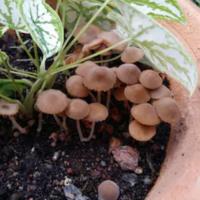Causes and Treatments for Mold on Houseplants
by Guest Post on Jan 27, 2011
Your houseplants are breathing the same air that you are so if you start to see mold growing on the leaves, stems, and soil of your houseplants, you need to take action. The bad news is that mold can be dangerous for humans, animals, and plants … the good news is that you’re about to find out how to remove it and prevent it from ever coming back.
Where Mold Comes From
Mold spreads quickly, easily, and unceasingly by spreading millions of spores through the air. Mold spores are everywhere and they can grow on almost any organic material. Mold is very fond of high humidity, high temperatures (75°F and above), darkness, and stagnant air. Sudden temperature changes can also cause mold spores to release from existing colonies, creating a crisis for you and your plants.
Characteristics of Mold
Check to see if the mold on your houseplants is active or dormant. Active mold appears fuzzy and soft and will smear easily when touched. Dormant mold should appear powdery and can be easily wiped off - but don’t do it inside the house! Spores will escape and grow elsewhere.
Mold can be found anywhere on your plants: leaves, flowers, stems, and even the soil that your plant grows in. Various types of mold can affect your plants negatively … anything from weakening them by compromising your plant’s ability to absorb oxygen, water, and nutrients to killing it outright. Mold removal from your plant comes down to a few basic steps.
How to Remove Mold from Houseplants
In all cases, take the plant outside to treat it and, to be safe, wear rubber gloves. Mold spores will spread in the process of treating your houseplant and some types of mold are toxic to humans. Make sure the mold spores don’t spread inside your house!
- Cut away the affected parts of the plant including dead and dying leaves and flowers.
- Remove any mold found in the soil by removing an inch of affected soil and replacing it with fresh indoor plant soil.
- Spray the plant with a simple, homemade, non-toxic fungicide: fill a spray bottle with water, add a tablespoon of baking soda and a teaspoon of vegetable oil and spray the whole plant with the mixture.
- Increase the air circulation in the area in which the plant lives and make sure it gets as much sun as the plant can bear. Sunlight is mold’s worst enemy!
Try Some Simple Prevention Techniques
- Add milk to your watering schedule to boost your houseplant’s immunity to mold. Use 1 part milk to 10 parts water.
- Water the base of the plant and take care to keep water off of the leaves and flowers of the plant.
- Remove leaves near the soil. Warm, damp, mulchy conditions will help the mold to grow.
- Make sure there is plenty of air circulating around your plant and give it a little sunshine.
- Be careful not to overwater which creates the overly moist, warm environment that mold loves. Houseplants usually do not require watering until the top inch of soil is dry.
- If you live in an area with high humidity, use a dehumidifier and try to keep the temperature and humidity as constant as possible.
Mold on your houseplants is unsightly at best and a health hazard at worst. Fortunately, most mold is fairly easy to treat … and even easier to prevent. Use the tips above, act fast, be consistent and your houseplants can be mold free year round!
Popular Articles
Three Places to Spend Money on the Exterior of Your Home
When you have the exterior of your home remodeled, you are investing, time, energy and convenience into the project and you want to make sure that...
105128 Views
Homemade Headboards-Make an Upholstered or Wooden Headboard
Homemade headboards can add a lot of personality to any bedroom. They can be coordinated with existing furniture and room decor or they can be the...
80248 Views
When to Use a Brush, Roller or Sponge Brush
Brushes are a good choice for painting trim and woodwork. They are also useful for cutting in the edges around the top and bottom edges and corners...
72890 Views
Creating a Cottage Kitchen with Bead Board
Kitchen decor can range from modern and bold to elegant and elaborate by using strategic kitchen pieces. One of the most popular decorating trends...
58661 Views
Gas Fireplace Diagnostics and Troubleshooting
Follow these steps for diagnosing and troubleshooting Gas Fireplaces repairs. For the average DIYer, this may seem intimidating, depending on the...
35683 Views
Latest Articles
Why Professional Boiler Repair is Essential for Home Safety and Comfort
Maintaining a warm and safe home environment is paramount for any homeowner. Your home's boiler system plays a critical role in this, but what...
on Nov 5, 2025
How to Keep Your Home Warm in the Winter
How to Keep Your Home Warm in the WinterAs winter approaches, keeping your home warm becomes a priority for comfort and health. Efficient heating...
on Oct 29, 2025
Why Reliable Furnace Repair is Essential for Winter Comfort
As the cold season approaches, homeowners recognize the critical role that a well-functioning furnace plays in ensuring a warm and cozy living...
on Oct 29, 2025
How Much Does it Cost to Take a Bath?
Plumbers know that a bath may seem like a relaxing luxury, but the real cost extends far beyond your water bill. The average soak uses 35 to 50...
on Apr 8, 2025
10 Concrete Patio Ideas on a Budget
A concrete patio can be a game-changer for your outdoor space. It is durable, versatile, and can be customized to fit your style. But what if you...
on Mar 25, 2025
Featured Articles
What Type of Licensed Contractor Should You Hire?
on Feb 28, 2017
Hire Contractors / Estimates

Looking for a specialty project? There are many types of contractors available for your home improvement needs. Finding the right type of...
Actions
Top Categories
- Garden / Landscaping / Patio — 264
- Kitchen / Bathrooms — 240
- Real Estate / Finance — 203
- Appliance / Repair — 186
- Interior Design / Decor — 184
- HVAC / Air Conditioning — 150
- Cleaning / Maintenance — 144
- Improvements / Remodeling — 131
- Plumbing / Basements — 118
- Floors / Tile / Hardwood — 116
- Safety / Security — 114
- Doors / Garages — 113
Articles Archive
More DIY Articles
Installing Ceramic Tile
Whether you are replacing an old tile floor or installing a new one this step-by-step guide will walk you through the installation process. The...
9 Cool Ideas for Wall Art with Wood Prints
The interior of your home reflects your personal style. To make some influential changes and get a relaxing mood, decorate your house walls with...
5 Tips for a Quality Water Damage Restoration Project
There are several situations that can lead to water damage in the home. Anything from natural disasters such as typhoons and whirlwinds, which...
Down and Dirty - Understanding Your Soil
The very first consideration in new landscaping should be the condition of the native soil; the most beautiful design and efficient planning will...
Ohio Local Builders Associations
Find a local builder or council, please contact the home builders' association (HBA) in your area.

